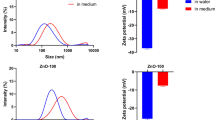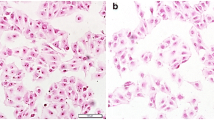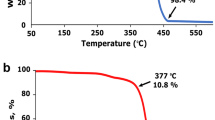Abstracts
Polystyrene nanoplastics (PS-NPs) have recently been found to be present in human blood and kidney. However, the renal toxicity of PS-NPs and the underlying mechanisms have not been fully elucidated. Here, we found that exposure of PS-NPs induced apoptosis of human renal proximal tubular epithelial cells (HK-2) in a size- and dose-dependent manner as revealed by AnnexinV-FITC assay. In addition, PS-NPs promoted ROS production and caused structure changes of mitochondrial and endoplasmic reticulum. Mechanistically, transcriptional sequencing indicated the involvement of MAPK pathway in apoptosis, which was further confirmed by the upregulation of p-p38, p-ERK, CHOP, BAX, cytochrome C, and caspase 3 expression. This study clarified the molecular mechanism underlying PS-NP-induced apoptosis in HK-2 cells and contributed to our risk estimation of PS-NPs in human kidney.







Similar content being viewed by others
Data availability
The datasets used and/or analyzed during the current study are available from the corresponding author on reasonable request.
References
Bhagatte Y, Lodwick D, Storey N (2012) Mitochondrial ROS production and subsequent ERK phosphorylation are necessary for temperature preconditioning of isolated ventricular myocytes. Cell Death Dis 3:e345
Cartron PF, Gallenne T, Bougras G, Gautier F, Manero F, Vusio P, Meflah K, Vallette FM, Juin P (2004) The first alpha helix of Bax plays a necessary role in its ligand-induced activation by the BH3-only proteins Bid and PUMA. Mol Cell 16:807–818
Chiu HW, Xia T, Lee YH, Chen CW, Tsai JC, Wang YJ (2015) Cationic polystyrene nanospheres induce autophagic cell death through the induction of endoplasmic reticulum stress. Nanoscale 7:736–746
Choi SY, Kim MJ, Kang CM, Bae S, Cho CK, Soh JW, Kim JH, Kang S, Chung HY, Lee YS, Lee SJ (2006) Activation of Bak and Bax through c-abl-protein kinase Cdelta-p38 MAPK signaling in response to ionizing radiation in human non-small cell lung cancer cells. J Biol Chem 281:7049–7059
Choi YJ, Park JW, Lim Y, Seo S, Hwang DY (2021) In vivo impact assessment of orally administered polystyrene nanoplastics: biodistribution, toxicity, and inflammatory response in mice. Nanotoxicology 15:1180–1198
Deng Y, Zhang Y, Lemos B, Ren H (2017) Tissue accumulation of microplastics in mice and biomarker responses suggest widespread health risks of exposure. Sci Rep 7:46687
Díaz-Torres ER, Ortega-Ortiz CD, Silva-Iñiguez L, Nene-Preciado A, Orozco ET (2017) Floating marine debris in waters of the Mexican Central Pacific. Mar Pollut Bull 115:225–232
Edlich F (2018) BCL-2 proteins and apoptosis: recent insights and unknowns. Biochem Biophys Res Commun 500:26–34
Geyer R, Jambeck JR, Law KL (2017) Production, use, and fate of all plastics ever made. Sci Adv 3:e1700782
Haque MS, Uddin S, Sayem SM, Mohib KM (2021) Coronavirus disease 2019 (COVID-19) induced waste scenario: a short overview. J Environ Chem Eng 9:104660
Hu M, Palić D (2020) Micro- and nano-plastics activation of oxidative and inflammatory adverse outcome pathways. Redox Biol 37:101620
Jambeck JR, Geyer R, Wilcox C, Siegler TR, Perryman M, Andrady A, Narayan R, Law KL (2015) Marine pollution. Plastic waste inputs from land into the ocean. Science (New York, N.Y.) 347:768–771
Jiang Q, Li F, Shi K, Wu P, An J, Yang Y, Xu C (2014) Involvement of p38 in signal switching from autophagy to apoptosis via the PERK/eIF2α/ATF4 axis in selenite-treated NB4 cells. Cell Death Dis 5:e1270
Jürgensmeier JM, Xie Z, Deveraux Q, Ellerby L, Bredesen D, Reed JC (1998) Bax directly induces release of cytochrome c from isolated mitochondria. Proc Natl Acad Sci USA 95:4997–5002
Kinga K, Bożena B, Anita K, Paulina S (2021) Oxidative properties of polystyrene nanoparticles with different diameters in human peripheral blood mononuclear cells (In Vitro Study). Int J Mol Sci 22(9):4406
Leslie HA, van Velzen MJM, Brandsma SH, Vethaak AD, Garcia-Vallejo JJ, Lamoree MH (2022) Discovery and quantification of plastic particle pollution in human blood. Environ Int 163:107199
Li Y, Li Y, Li J, Song Z, Zhang C, Guan B (2023) Toxicity of polystyrene nanoplastics to human embryonic kidney cells and human normal liver cells: effect of particle size and Pb(2+) enrichment. Chemosphere 328:138545
Mahdi MA, Yousefi SR, Jasim LS, Salavati-Niasari M (2022) Green synthesis of DyBa2Fe3O7.988/DyFeO3 nanocomposites using almond extract with dual eco-friendly applications: photocatalytic and antibacterial activities. Int J Hydrog Energy 47:14319–14330
Mason SA, Garneau D, Sutton R, Chu Y, Ehmann K, Barnes J, Fink P, Papazissimos D, Rogers DL (2016) Microplastic pollution is widely detected in US municipal wastewater treatment plant effluent. Environ Pollut (Barking, Essex : 1987) 218:1045–1054
Mehdizadeh P, Jamdar M, Mahdi MA, Abdulsahib WK, Jasim LS, Raheleh Yousefi S, Salavati-Niasari M (2023) Rapid microwave fabrication of new nanocomposites based on Tb-Co-O nanostructures and their application as photocatalysts under UV/Visible light for removal of organic pollutants in water. Arab J Chem 16:104579
Meng X, Zhang J, Wang W, Gonzalez-Gil G, Vrouwenvelder JS, Li Z (2022) Effects of nano- and microplastics on kidney: physicochemical properties, bioaccumulation, oxidative stress and immunoreaction. Chemosphere 288:132631
Miller AL, Webb MS, Copik AJ, Wang Y, Johnson BH, Kumar R, Thompson EB (2005) p38 Mitogen-activated protein kinase (MAPK) is a key mediator in glucocorticoid-induced apoptosis of lymphoid cells: correlation between p38 MAPK activation and site-specific phosphorylation of the human glucocorticoid receptor at serine 211. Mol Endocrinol (Baltimore, Md.) 19:1569–1583
Osman AI, Hosny M, Eltaweil AS, Omar S, Elgarahy AM, Farghali M, Yap PS, Wu YS, Nagandran S, Batumalaie K, Gopinath SCB, John OD, Sekar M, Saikia T, Karunanithi P, Hatta MHM, Akinyede KA (2023) Microplastic sources, formation, toxicity and remediation: a review. Environ Chem Lett:1–41. https://doi.org/10.1007/s10311-023-01593-3
Patnaik A et al (2016) A first-in-human phase I study of the oral p38 MAPK inhibitor, ralimetinib (LY2228820 Dimesylate), in patients with advanced cancer. Clin Cancer Res : Off J Am Assoc Cancer Res 22:1095–1102
Pivokonsky M, Cermakova L, Novotna K, Peer P, Cajthaml T, Janda V (2018) Occurrence of microplastics in raw and treated drinking water. Sci Total Environ 643:1644–1651
Romine IC, Wiseman RL (2019) PERK signaling regulates extracellular proteostasis of an amyloidogenic protein during endoplasmic reticulum stress. Sci Rep 9:410
Sato A, Okada M, Shibuya K, Watanabe E, Seino S, Narita Y, Shibui S, Kayama T, Kitanaka C (2014) Pivotal role for ROS activation of p38 MAPK in the control of differentiation and tumor-initiating capacity of glioma-initiating cells. Stem Cell Res 12:119–131
Song YK, Hong SH, Eo S, Han GM, Shim WJ (2020) Rapid production of micro- and nanoplastics by fragmentation of expanded polystyrene exposed to sunlight. Environ Sci Technol 54:11191–11200
Sun H, Jiao R, Wang D (2021) The difference of aggregation mechanism between microplastics and nanoplastics: role of Brownian motion and structural layer force. Environ Pollut (Barking, Essex : 1987) 268:115942
Tang Y, Zhao R, Pu Q, Jiang S, Yu F, Yang Z, Han T (2023) Investigation of nephrotoxicity on mice exposed to polystyrene nanoplastics and the potential amelioration effects of DHA-enriched phosphatidylserine. Sci Total Environ 892:164808
Vethaak AD, Legler J (2021) Microplastics and human health. Science (New York, N.Y.) 371:672–674
Vince JE et al (2018) The mitochondrial apoptotic effectors BAX/BAK activate caspase-3 and -7 to trigger NLRP3 inflammasome and caspase-8 driven IL-1β activation. Cell Rep 25:2339–2353.e4
Wang B, Feng WY, Wang TC, Jia G, Wang M, Shi JW, Zhang F, Zhao YL, Chai ZF (2006) Acute toxicity of nano- and micro-scale zinc powder in healthy adult mice. Toxicol Lett 161:115–123
Wang Y-L, Lee Y-H, Hsu Y-H, Chiu IJ, Huang CC-Y, Huang C-C, Chia Z-C, Lee C-P, Lin Y-F, Chiu H-W (2021) The kidney-related effects of polystyrene microplastics on human kidney proximal tubular epithelial cells hk-2 and male c57bl/6 mice. Environ Health Perspect 129(5):57003
Xu M, Halimu G, Zhang Q, Song Y, Fu X, Li Y, Li Y, Zhang H (2019) Internalization and toxicity: a preliminary study of effects of nanoplastic particles on human lung epithelial cell. Sci Total Environ 694:133794
Yang Y, Jiang G, Zhang P, Fan J (2015) Programmed cell death and its role in inflammation. Mil Med Res 2:12
Yang Y, Kim SC, Yu T, Yi YS, Rhee MH, Sung GH, Yoo BC, Cho JY (2014) Functional roles of p38 mitogen-activated protein kinase in macrophage-mediated inflammatory responses. Mediat Inflamm 2014:352371
Yee MS, Hii LW, Looi CK, Lim WM, Wong SF, Kok YY, Tan BK, Wong CY, Leong CO (2021) Impact of microplastics and nanoplastics on human health. Nanomater (Basel, Switzerland) 11(2):496
Yu J, Chen L, Gu W, Liu S, Wu B (2022) Heterogeneity effects of nanoplastics and lead on zebrafish intestinal cells identified by single-cell sequencing. Chemosphere 289:133133
Zhang Q, Xu EG, Li J, Chen Q, Ma L, Zeng EY, Shi H (2020) A review of microplastics in table salt, drinking water, and air: direct human exposure. Environ Sci Technol 54:3740–3751
Funding
This work was supported by the National Natural Science Foundation of China (82170523, 81870261), Sichuan Youth Science and Technology Innovation Research Team (2020JDTD0024), Sichuan Science and Technology Program (2022YFS0610), and Collaborative Innovation Center for the Prevention and Treatment of Cardiovascular Diseases in Sichuan Province (xtcx2016-14, xtcx 2019-06).
Author information
Authors and Affiliations
Contributions
All authors contributed to the study conception and design. Material preparation, data collection, and analysis were performed by Zhu Zhu. Ruixue Liao, and Yang Shi. The first draft of the manuscript was written by Zhu Zhu, Jingyan Li, Guang Li. All authors read and approved the final manuscript.
Corresponding author
Ethics declarations
Ethics approval and consent to participate
Not applicable.
Consent for publication
Not applicable.
Competing interests
The authors declare no competing interests.
Additional information
Responsible Editor: Ludek Blaha
Publisher’s Note
Springer Nature remains neutral with regard to jurisdictional claims in published maps and institutional affiliations.
Supplementary information
ESM 1
(PDF 162 kb)
Rights and permissions
Springer Nature or its licensor (e.g. a society or other partner) holds exclusive rights to this article under a publishing agreement with the author(s) or other rightsholder(s); author self-archiving of the accepted manuscript version of this article is solely governed by the terms of such publishing agreement and applicable law.
About this article
Cite this article
Zhu, Z., Liao, R., Shi, Y. et al. Polystyrene nanoplastics induce apoptosis of human kidney proximal tubular epithelial cells via oxidative stress and MAPK signaling pathways. Environ Sci Pollut Res 30, 110579–110589 (2023). https://doi.org/10.1007/s11356-023-30155-x
Received:
Accepted:
Published:
Issue Date:
DOI: https://doi.org/10.1007/s11356-023-30155-x




